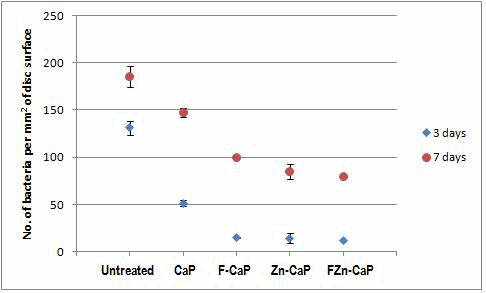Objectives: The two main areas of concern in implant therapy are biomaterial centered infection and successful tissue integration. Infection after implant placement accounts for about 14% of the total dental implant failures. The objective of this research was to develop calcium-phosphate (CaP) based thin coatings with antibacterial and bioactive properties for potential application in implants.
Methods: Acid-etched grit-blasted (AEGB) Ti-alloy discs were immersed in different calcifying solutions: CaP (positive control), F-CaP, Zn-CaP and FZn-CaP (n=20 per group), and kept in an incubator shaker for 24hrs. Negative control was uncoated AEGB discs. Coated surfaces were characterized using X-ray diffraction, electron dispersive spectroscopy and scanning electron microscopy (SEM). In vitro bioactivity was tested by immersing discs in simulated body fluid (SBF). Antibacterial properties were tested using Porphyromonas gingivalis ATCC 33277. �Media and culture controls were used to verify efficacy of sterilization and well-to-well contamination. Bacterial colonization was studied at 0, 3, 7 and 14 days using SEM, biofilm thickness and bacterial survival was assessed by confocal laser scanning microscopy after staining with BaclightTM LIVE/ DEAD� stain. The colony count and optical density of the culture media was determined each time.
Results: The coated surfaces had compositional characteristics similar to that of bone mineral and they inhibited the growth, colonization and adherence of P.gingivalis, resulted in reduced thickness of biofilms and bacterial inhibition in the supernatant culture medium as compared to the positive and negative controls (statistically significant p<0.05). There was no significant difference between the experimental groups (p>0.05). All CaP coatings formed carbonate hydroxyapatite when immersed in SBF.
Conclusion: The experimental calcium phosphate coatings on Ti implants were effective in inhibiting bacterial growth and colonization and demonstrated in vitro bioactivity. This study suggests that such coatings can enhance osseointegration and prevent infection in implants, thereby improving the success rates of implants.
Keywords: Antimicrobials, Implantology, Microbiology, Oral implantology and Surfaces
See more of: Implantology Research
![[ Visit AADR's Website ]](images/banner.jpg)
